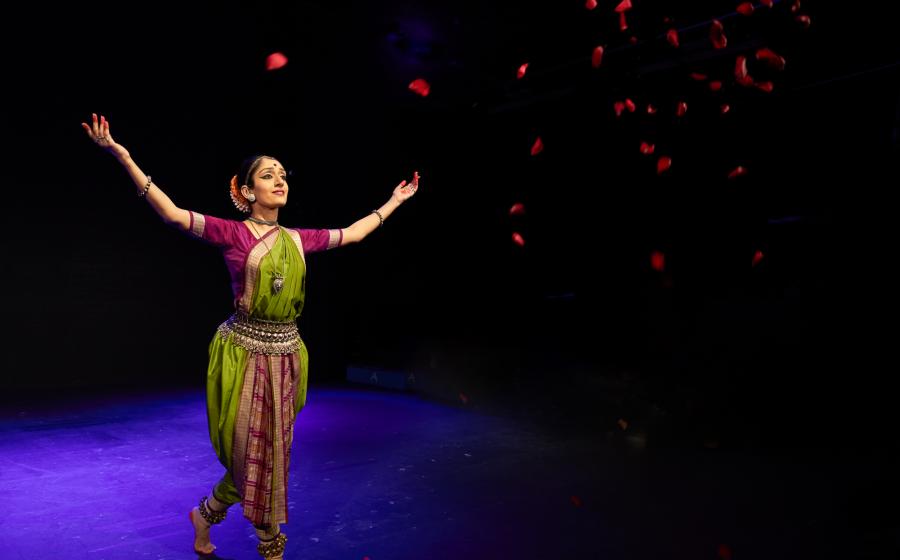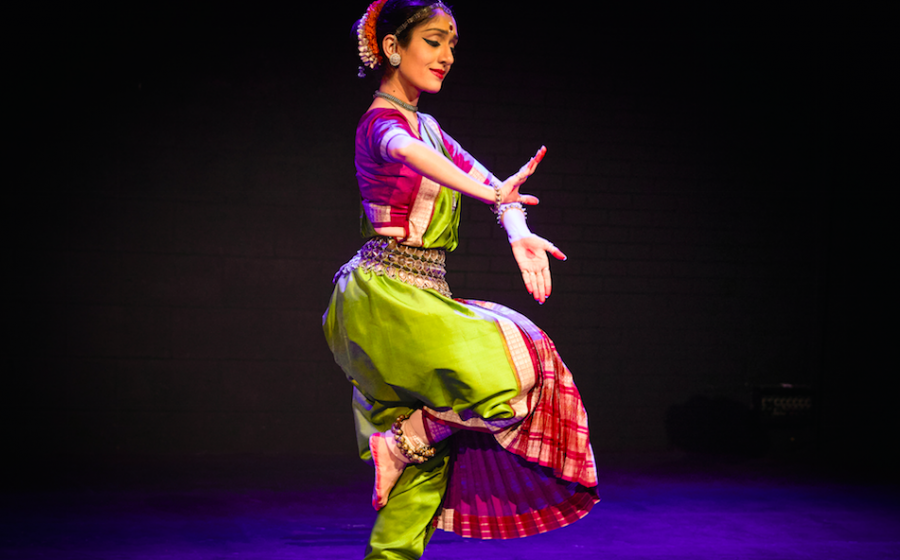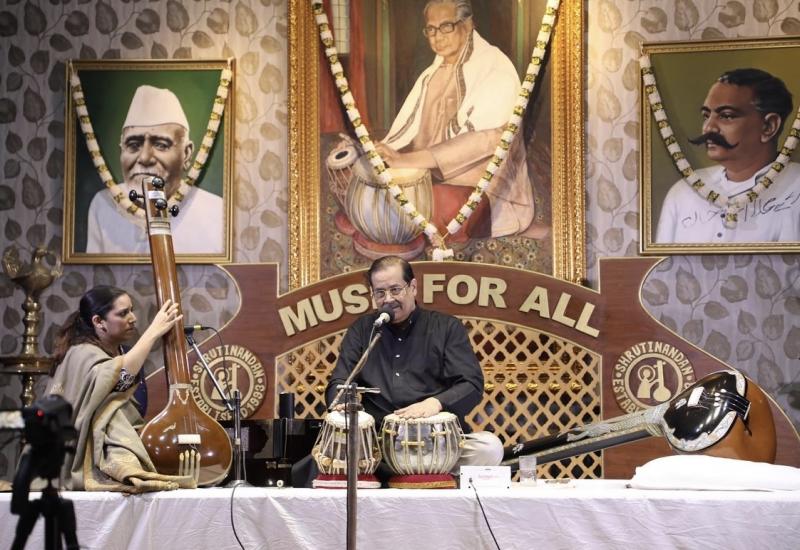Dancing to a new tune- Arushi Mudgal in Kamala
This Mini-Series examines the connection between new musical compositions and how these elicit new ways of moving, which may or may not be outside the strict classical form. Over 2023 in my normal course of attending performances and keeping abreast of developments in South Asian dance, I came across the works of three dancers which stood out for their freshness and originality. A large part of the appeal was the musical score to the dance which in turn influenced the choreography.
The first article focused on bharatanatyam artist Divya Ravi. In this second article I would like to throw light on Arushi Mudgal’s new odissi work, an invocatory item based on the Goddess Lakshmi, who is also referred to as ‘Kamala’. In order to contextualise the work, let me clarify that odissi as practised today is a relatively recent form, gaining recognition as a classical dance form in 1958. The repertoire of odissi was formed by four Gurus, the most prominent of whom is Guru Kelucharan Mohapatra (8 Jan 1926-7 April 2003). Even today, more than half the items performed worldwide have been choreographed by Kelucharan Mohapatra. The items created by him are so indelibly imprinted on the minds of odissi practitioners that to break and form new structures is a relatively unusual phenomenon. It is for this reason that Arushi Mudgal’s new work Kamala is like a starburst of creativity!
Arushi Mudgal has grown up surrounded by music and dance. She was introduced to odissi by her father’s sister the renowned Madhavi Mudgal, who has been her guru for three decades. Her father Mudhup Mudgal is a Hindustani vocalist and composer and since 1995 principal of the oldest music and dance institute in New Delhi, Gandharva Mahavidyalaya, set up by his father in 1939. Her sister Sawani is also a singer. Despite these advantages, Arushi’s achievements are purely her own. In Kamala we see her independent approach to making dance.
The usual format of an odissi mangalacharan – invocation – is as follows: a slow entry, pushpanjali (floral offering); sloka (verse), in praise of a god in several verses to which the dancer performs and emotes; ending with a set piece trikhandi pranam (salutation). Based on the concept of a mangalacharan, Arushi Mudgal extends the boundaries in a multi-layered choreography supported by a musical arrangement that follows her imagination.
It opens with a sweetness of voice and gesture, as the seated woman (dancer) is singing in praise of the devi, while her hands perform a series of ritual actions. The Oriya lyrics, lilting rhythm and the simplicity of delivery capture the heart – this is but an ordinary village woman. We then hear the strains of a village procession and the assorted sounds that go with chariots with the deity installed, being pulled while cymbals are struck and flowers strewn in the path, recalling Jaggernath Swami, an item created by guru and aunt Madhavi Mudgal. Then follows a beautiful shloka evoking Lakshmi, her radiance that bestows good fortune and prosperity, sung by Mudhup Mudgal to a composition of Pandit Jasraj. Next the audience is catapulted into a rap-like kavit, where the aspects and names of the Goddess are strung into rhythmic verse. This is a lovely surprise, as we frequently hear kavits in kathak, but I cannot recall one in an odissi item. From the staccato of the kavit, we are led into fluid nritta sequences that are far more elaborate than we have seen in a mangalacharan before, and are delivered with an ease and unhurriedness. The laya varies and the depth of the bhangis is maintained even at speed. The various ways of using the foot: heel, stamp, slide, flick; and the arm and body movements, ending in intriguing tehais: one with a leap and an arm drawing a line from peak to base is particularly memorable. Towards the end of the item there is a second song: and the conclusion refers back to the dying strains of the procession as the dancer gazes wistfully at the retreating worshippers. The audience is left enthralled. You can watch an edited version of Kamala here:
I wanted to better understand how Arushi had gone about creating Kamala. Her answers and observations will guide dancers making the same journey.
1. When you thought about Kamala, did the dance come first and then the music or both together?
I conceptualised and choreographed Kamala in 2014 for a dance festival curated by Malavika Sarukkai ji in Chennai. For me, there is no single answer to the question of whether the dance comes before the music or both together. It all starts with an idea that gradually takes shape into a more substantial vision mapping the flow of the piece in the mind. This flow keeps changing its course over the span of the entire process. With Kamala, there were parts where the music came first (like the shlok composed by Pandit Jasraj which was already set). Then there were parts – like the procession segment – that I conceptualised first, and then worked with my father, Madhup Mudgal ji, on the music. He then composed music for those parts keeping in mind the concept, after which I created the choreography.
2. What were your stipulations for the composer?
Undoubtedly, music lays the foundation for my choreography. The uniqueness about Madhupji’s music is that it always naturally reflects and complements the overall concept of the piece, and is not created in isolation focusing only on musical splendour. The composition often happens at our dining table that he uses as a percussive instrument to play the rhythm on, and I record him on my phone. I am always open to receiving inputs from him at any point of the choreography process. Many a time, even after I have set some choreography, he may come up with some fresh ideas and variations in the music. I usually incorporate these inputs even at a later stage, because I find that this helps me keep the entire process organic. It’s a give and take, and with creativity, one cannot be bound.
With Kamala too, I discussed the idea of the piece with him in much detail giving him a sense of my vision. I had a tentative structure of the piece in my mind that I discussed with him, and I heard his ideas on the same. Kamala was special because I wanted to give a flavour of the Devi rituals of Odisha through the piece. So he composed each segment keeping that in mind. In the part with the procession, he used various folk percussion instruments of Odisha along with the melodic instruments of flute and sitar, and the melody itself has a folkish lilt.
3. I noticed that you used an Oriya song, a kavit and Pandit Jasraj composition together with Odissi bol; what was the idea behind it?
When I first thought about Kamala, my basic idea was that I wanted to create a mangalācharan invoking Lakshmi. While choreographing, often images of how a piece will unfold start appearing in the mind before I start thinking of the movements. I mean more in terms of the structure in the initial stage. With Kamala, as I delved deeper into the space of the goddess, researched and learned more about Her attributes and the various rituals/prayers of worshipping Her especially in Odisha, I started wondering about the relationship of the devotee with the goddess.
That is when I thought of creating this invocation with a more personal approach, and not base it on the traditional format of a mangalācharan. I began to ask people in Odisha about the songs they sing in Her praise. I chose to begin the piece with one short excerpt from such a prayer-song in the Oriya language that I decided to sing myself (a suggestion of the devotee’s personal connection with the Devi). As for the kavit, I wrote it by weaving together various names and attributes of Lakshmi taken from the Sanskrit text Sri Suktam. I find kavits very beautiful; their incorporation of rhythmic syllables and musicality is quite unique. I used the recitation of the bols to create a semblance of a dialogue between Devi and the devotee. The two verses sung in the piece are compositions of Pandit Jasraj and Madhupji, again from Sri Suktam. Madhupji sang Pandit ji’s composition of Sarasijanilaye, while Bhuvanesh Komkali sang Madhup ji’s composition. Each element – be it the Oriya song, kavit, bols or the text – was there for a specific reason, while adding a distinct stroke on the overall character of the piece.
4. Do you feel that the new compositions brought out different ways of moving?
Music leads my movements; I spontaneously respond to it. So even a very traditional musical phrase could inspire me to create a novel way of moving. Good music, old or new, has infinite layers to offer, whether in terms of the melody or its inherent rhythm. I really enjoyed creating dance to the myriad musical tones that Kamala offers. And whether consciously or without realising, a lot of fresh/different movements were created in the process.
5. Do you feel that there is a trend towards opening up the classical repertoire?
Perhaps. But I would rather have the repertoire expand organically, than creating work with the sole intention of expanding it. As a choreographer, what I find exciting is to seek different paths to arrive at the destination, whether in terms of micro movements, or the overall structure of the piece, or even the repertoire. Finding newness in music and dance depends a lot on our understanding and sensibilities as artists. Each choreographer’s work reflects their vision.
Some try to create new work for the sake of being different while some do it without even realising. I personally believe in a more organic approach to creativity. I like all the elements to flow and unravel, fresh in every moment. Which is why many of my choreographic works take off from a certain thought with a specific route in mind, but eventually make a completely different journey. And that sense of mystery is what I love about the process of creation. The idea of expanding the repertoire, therefore, is not the intent, but perhaps an incidental result, if at all.













